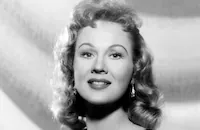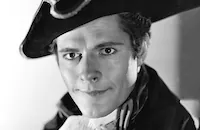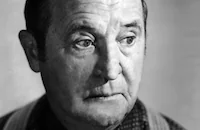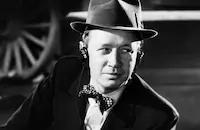Wonder Man

Brief Synopsis
Cast & Crew
Bruce Humberstone
Danny Kaye
Virginia Mayo
Vera-ellen
Donald Woods
S. Z. Sakall
Film Details
Technical Specs

Synopsis
As flamboyant nightclub entertainer Buster "Buzzy" Bellew prepares to testify in a murder trial against mobster Ten Grand Jackson, he also arranges to marry his girl friend and fellow singer, Midge Mallon, in two days. Soon after, however, he is murdered by Jackson's thugs, Torso and Chimp. At the moment Buzzy is killed, his estranged "superidentical" twin brother, the staid genius Edwin Dingle, begins to hear music and thinks of Buzzy. Although the shy Edwin manages to arrange a date for that evening with librarian Ellen Shanley, he hears Buzzy calling him and is compelled to leave the date and wander into the park. There, Buzzy's ghost appears and convinces Edwin he is dead by playing pranks on other people, to whom he is invisible. He proposes that Edwin pretend to be him in order to testify against Jackson, and promises to inhabit Edwin's body to help him out whenever the charade becomes too difficult. Although Edwin attempts to return to Ellen that night, Buzzy compels him to visit his nightclub, where Edwin acts hopelessly out of place until Buzzy finally inhabits his body and performs his routine. Edwin then calls Ellen, but after she hangs up on him furiously, he gets so drunk that Buzzy passes out. Meanwhile, Jackson, who has seen Edwin on stage, assumes his men have botched the murder and orders them to try again. The next day, when Ellen sees Edwin outside the library running from Torso and Chimp and then being escorted by the police to District Attorney O'Brien's office, she believes he is deranged. O'Brien insists that Edwin give his statement, and when Buzzy does not arrive to inhabit him, Edwin invents an obviously false story, which causes O'Brien to throw him out in disgust. At the same time, Midge waits two hours at the church for Buzzy to marry her, and finally asks nightclub owner Monte Rossen to marry her instead. Ellen then calls O'Brien for information on Edwin and discovers the district attorney is at the opera. When Edwin arrives to tell her the whole story again, she shuts him out of the house. At that moment, however, Torso and Chimp hold her up, and their questions convince her that Edwin has told the truth. Edwin bursts into the apartment, inadvertently revealing himself to the thugs, who chase him out. As he runs, Buzzy finally wakes from his drunken stupor and tells Edwin that he witnessed Jackson murdering a fan dancer, who stashed the evidence against the gangster in a safe-deposit box under the name Minnie Smith. Buzzy then reveals that he has "run out of ectoplasm" and can no longer inhabit him, leaving Edwin sole responsibility for relating the information to O'Brien. Edwin and Ellen race separately to the opera, and during the performance, Edwin escapes from Torso and Chimp by disguising himself as a soloist. On stage, he begins singing Buzzy's testimony out to O'Brien's box seats until Ellen makes her way into the box and explains what has happened. O'Brien directs the security guards to arrest Torso and Chimp, and the next day, Jackson is convicted as Edwin and Ellen marry in a double service with Midge and Monte. On their honeymoon, Edwin reveals that he now has learned to combine Buzzy's charm with his own brilliance.

Director

Bruce Humberstone
Cast

Danny Kaye

Virginia Mayo

Vera-ellen

Donald Woods

S. Z. Sakall

Allen Jenkins

Edward Brophy

Steve Cochran

Otto Kruger

Richard Lane
Natalie Schafer

Huntz Hall

Virginia Gilmore
Ed Gargan
Alice Mock
Gisela Werbiseck
Ruth Valmy

Alma Carroll
Georgia Lange
Karen X. Gaylord
Mary Moore
Gloria Delson
Deannie Best
Chili Williams
Mary Meade
Martha Montgomery
Ellen Hall
Phyllis Forbes
Mary Jane Woods
Katharine Booth
Al Ruiz
Willard Van Simons
Jack Norton

Charles Irwin

Frank Orth

Cecil Cunningham
Chester Clute

James Flavin
Mary Field

Eddie Kane

Ray Teal
Leon Belasco
Billy Wayne
Eddie Dunn

Ralph Dunn
Maurice Cass
Luis Alberni
Aldo Franchetti
Roseanne Murray

Eddie Acuff
John Kelly

Byron Foulger
William Newell
Sarah Selby
Harry Depp
James Farley
Frank Melton
Margie Stewart
Barbara La Rene
Noel Cravat
Nick Thompson
Nino Pipitone
Baldo Minuti
Maureen Cunningham
Georgann Smith
Janet Lavis
Dorothy Jean
Betty Marion
Jane Allen
Doris Toddings
Jean Marley
Helen Mcallister
Virginia Kepler
Helen Mcgowan
Carolyn Haney
Charles Teske
Ray Nyles
Walter Pietila
Bob Mascagno
Eddie Cutler
Allen Pinson
Grace Johnson
Dorothy Koster
Loretta Daye
Susan Scott
Alice Stansfield
Billie Lane
Mickey Malloy
Alice Kersten
Crew
Travis Banton
Howard Bristol
Mcclure Capps
Doug Denis
Ernst Fegté
Perry Ferguson
Sylvia Fine
Louis Forbes
Harve Foster
John Fulton
Samuel Goldwyn
Samuel Goldwyn
Don Hartman
Ray Heindorf
Jack Jevne
Arthur Johns
Natalie Kalmus
Mitchell Kovaleski
Fred Lau
Daniel Mandell
William Mcgarry
Victor Milner
Eddie Moran
Paul Neal
Philip Rapp
Harry Redmond
Nina Roberts
Leo Robin
David Rose
David Rose
Gordon Sawyer
Melville Shavelson
Arthur Sheekman
William Snyder
Murray Spivack
Robert Stephanoff
Karl Struss
John Wray

Videos
Movie Clip
Hosted Intro
Film Details
Technical Specs

Award Wins
Best Special Effects
Award Nominations
Best Score
Best Song
Best Sound
Articles
Wonder Man
The producer tapped the capable Bruce Humberstone to direct Wonder Man; a versatile director, he enjoyed previous musical successes with Sun Valley Serenade (1941) and Hello Frisco, Hello (1943). Goldwyn brought back screenwriter Don Hartman from Up in Arms, added Melville Shavelson (who had collaborated with Hartman on the Goldwyn-Bob Hope vehicle The Princess and the Pirate (1944), Philip Rapp (he created Baby Snooks for Fanny Brice), Arthur Sheekman (gag writer for the Marx Brothers), Jack Jevne and Eddie Moran, all working to fashion a storyline that could contain and showcase Danny Kaye's prodigious range of talents.
This creative team came up with the story of a murdered nightclub entertainer who comes back from the grave to haunt his bookish twin brother so that the flamboyant twin Buzzy Bellew can get his shy sibling Edwin Dingle -- to testify against the gangster who had him killed. It could have been an eerie supernatural tale, but not with Danny Kaye in the lead. With Buzzy's ectoplasm egging him on, Edwin embarks on an eccentric adventure including stops at Brooklyn's Prospect Park, a nightclub stage, an intense grilling at the District Attorney's office, and finally a grand opera production where Edwin must integrate his testimony into the libretto. Kaye began to hone his craft from the time he was a tummler in the Catskill Mountain resorts. Later, during his overseas tours before non-English speaking audiences, he learned to win over an audience through gestures using his elegant hands. It was after his smash runs at New York nightclub La Martinique in the early 1940s and the Broadway shows Lady in the Dark and Let's Face It that Hollywood came calling. And no one was better qualified to bring to life Wonder Man's complicated plot which completely relied on Kaye's versatility and charismatic personality to make it work.
Actress Virginia Mayo, who had appeared in a handful of movies up to this point, including an uncredited Goldwyn Girl cameo in Up in Arms, had acquitted herself well opposite Bob Hope in The Princess and the Pirate. As a result, Goldwyn saw a complementary pairing in the beautiful Mayo and the energetic Kaye and his instincts were right. The couple radiated an on-screen chemistry that led to three more films together for Goldwyn after Wonder Man.
The second female lead was a talented newcomer discovered by Samuel Goldwyn and brought to Hollywood for her screen debut in Wonder Man. Vera Ellen Westmeyer Rohe, who would use Vera-Ellen as her screen name, had been a dancer since childhood, winning a Major Bowes competition and soon becoming the youngest Rockette at Radio City Music Hall. She soon began appearing in Broadway musicals, including Panama Hattie with Ethel Merman and By Jupiter with Ray Bolger, and really broke out with her role in the revival of A Connecticut Yankee in 1943 where she sang and danced as one of the leads. Goldwyn liked what he saw, and cast the fresh-faced, energetic and wholesome twenty-three year old as the singing dancing girlfriend of Buzzy Bellew. (Though she sang on Broadway, Vera-Ellen wouldn't be allowed to use her own voice in her movie musicals and was dubbed in all her films.) She's one of the most athletic of female movie dancers, with a fierce but graceful muscularity that paired perfectly with Kaye's ebullient but non-traditional approach to dancing.
Danny Kaye's wife, composer Sylvia Fine, devised several specialty numbers for her husband for Wonder Man, including the bouncy "Bali Boogie" performed with Vera-Ellen, during which he managed to injure his ankle jumping out of a giant drum, holding up production for several weeks. Fine also devised a comic version of the Russian standard "Otchi Chorniya" plus the clever madcap opera finale that wraps up the plot. Songwriters Leo Robin and David Rose wrote a catchy tune "So in Love" for Vera-Ellen's big solo song and dance.
Most reviewers enjoyed seeing what the dynamic but sometimes exhaustingly-talented Danny Kaye could do in his second screen outing and generally conceded that Kaye's contributions to Wonder Man far exceeded the formulaic screenplay. The movie's top-notch technical achievements were also singled out for recognition. Kaye's twin brother interactions were made possible by seamless and state-of-the-art (for its time) techniques which earned John P. Fulton (photographic) and Arthur Johns (sound) the Academy Award for Best Effects, Special Effects at the 1945 Awards. (Wonder Man's script contained an amusing in-joke when the ghostly Buzzy slips his torso onto a park statue, and asks Edwin "What is this, trick photography?"). The film also received nominations for "So in Love" as Best Music, Original Song, for Louis Forbes and Ray Heindorf for Best Music, Scoring of a Motion Picture, and for Gordon Sawyer for Best Sound, Recording.
Producer: Samuel Goldwyn
Director: H. Bruce Humberstone
Screenplay: Arthur Sheekman, Jack Jevne, Eddie Moran, Don Hartman, Melville Shavelson, Philip Rapp
Cinematography: Victor Milner, William Snyder
Film Editing: Daniel Mandell
Art Direction: Ernst Fegte
Music: Ray Heindorf, Heinz Roemheld
Cast: Danny Kaye (Edwin Dingle), Virginia Mayo (Ellen Shanley), Vera-Ellen (Midge Mallon), Donald Woods (Monte Rossen), S.Z. Sakall (Schmidt), Allen Jenkins (Chimp).
C-98m.
by Lisa Mateas

Wonder Man
Virginia Mayo (1920-2005)
She was born Virginia Clara Jones in St. Louis, Missouri on November 30, 1920, and got her show business start at the age of six by enrolling in her aunt's School of Dramatic Expression. While still in her teens, she joined the nightclub circuit, and after paying her dues for a few years traveling across the country, she eventually caught the eye of movie mogul Samuel Goldwyn. He gave her a small role in her first film, starring future husband, Michael O'Shea, in Jack London (1943). She then received minor billing as a "Goldwyn Girl," in the Danny Kaye farce, Up In Arms (1944). Almost immediately, Goldwyn saw her natural movement, comfort and ease in front of the camera, and in just her fourth film, she landed a plumb lead opposite Bob Hope in The Princess and the Pirate (1944). She proved a hit with moviegoers, and her next two films would be with her most frequent leading man, Danny Kaye: Wonder Man (1945), and The Kid from Brooklyn (1946). Both films were big hits, and the chemistry between Mayo and Kaye - the classy, reserved blonde beauty clashing with the hyperactive clown - was surprisingly successful.
Mayo did make a brief break from light comedy, and gave a good performance as Dana Andrews' unfaithful wife, Marie, in the popular post-war drama, The Best Years of Their Lives (1946); but despite the good reviews, she was back with Kaye in The Secret Life of Walter Mitty (1947), and A Song Is Born (1948).
It wasn't until the following year that Mayo got the chance to sink her teeth into a meaty role. That film, White Heat (1949), and her role, as Cody Jarrett's (James Cagney) sluttish, conniving wife, Verna, is memorable for the sheer ruthlessness of her performance. Remember, it was Verna who shot Cody¿s mother in the back, and yet when Cody confronts her after he escapes from prison to exact revenge for her death, Verna effectively places the blame on Big Ed (Steve Cochran):
Verna: I can't tell you Cody!
Cody: Tell me!
Verna: Ed...he shot her in the back!!!
Critics and fans purred over the newfound versatility, yet strangely, she never found a part as juicy as Verna again. Her next film, with Cagney, The West Point Story (1950), was a pleasant enough musical; but her role as Lady Wellesley in Captain Horatio Hornblower R.N. (1951), co-starring Gregory Peck, was merely decorative; that of a burlesque queen attempting to earn a university degree in the gormless comedy, She¿s Working Her Way Through College (1952); and worst of all, the Biblical bomb, The Silver Chalice (1954) which was, incidentally, Paul Newman's film debut, and is a film he still derides as the worst of his career.
Realizing that her future in movies was slowing down, she turned to the supper club circuit in the 60s with her husband, Michael O'Shea, touring the country in such productions as No, No Nanette, Barefoot in the Park, Hello Dolly, and Butterflies Are Free. Like most performers who had outdistanced their glory days with the film industry, Mayo turned to television for the next two decades, appearing in such shows as Night Gallery, Police Story, Murder She Wrote, and Remington Steele. She even earned a recurring role in the short-lived NBC soap opera, Santa Barbara (1984-85), playing an aging hoofer named "Peaches DeLight." Mayo was married to O'Shea from 1947 until his death in 1973. She is survived by their daughter, Mary Johnston; and three grandsons.
by Michael T. Toole
Virginia Mayo (1920-2005)
Quotes
Potato salad!- Edwin Dingle
I don't want to go to Brooklyn. You can't make me. I don't *want* to go to Brooklyn.- Edwin
None of us want to, bud, but we all gotta go sooner or later.- Bus Driver
Do you remember you once told me you wouldn't be found dead in Brooklyn?- Edwin
Yeah, I remember. That was the only way they could get me here.- Buzzy's Ghost
Trivia
Notes
The film's working title was The Wonder Boy. Some sources also referred to it as The Wonder Man. According to a December 1943 Hollywood Reporter news item, Don Hartman was originally slated to write and associate produce the film, but the onscreen credits only credit him as a co-writer. The film began shooting on July 12, 1944 with Karl Struss as director of photography, David Rose as musical director and Perry Ferguson as art director, but production was suspended from 19 July to August 7, 1944 after Danny Kaye injured his leg during a dance routine. When shooting resumed, Victor Milner took over photography duties along with William Snyder, Louis Forbes became musical director, and Ernst Fegté became art director.
Wonder Man, which was Vera-Ellen's first film and Danny Kaye's second, opened to excellent reviews. According to the Variety review, some of Kaye's material had been used before in his stage shows, but was reworked for the screen by his wife, Sylvia Fine. In June 1943, Kaye had submitted the musical number "Anatole of Paris" to the War Department for approval for viewing by men abroad, and at that time, a Hollywood Reporter news item reports, it was deemed unacceptable because it depicted a Parisienne in an unflattering light. Other Hollywood Reporter news items add Bobby Summers, Gene Collins, Bertha Belmore, Alice Wallace, Grant Mitchell, Helen Chapman, Allan Dodel, Arleen Whelan and Allen Jenkins to the cast, but their appearance in the final film has not been confirmed. The picture received Academy Award nominations in the Music (Scoring of a Musical Picture); Sound Recording; and Music (Song-"So in Love") categories. It won an Academy Award in the Special Effects (Photographic Effects, John Fulton, and Sound Effects, Arthur Johns) category.
















